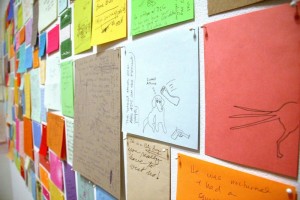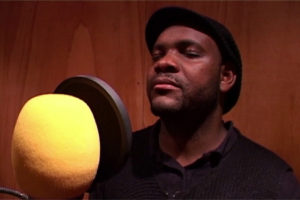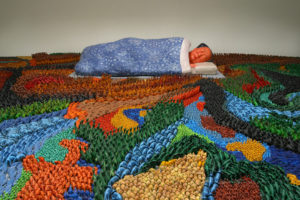“Ten Years of Conversations,” Joseph Grigely at Yerba Buena Center for the Arts
This piece was first published in the San Francisco Bay Guardian. It can be cited here as: Buckner, Clark. “Ten Years of Conversations: Joseph Grigley at Yerba Buena Center for the Arts,” www.clarkbuckner.com. Web. Day, Month, Year the post was accessed.
Since losing his hearing, Joseph Grigely has communicated with friends and others by exchanging notes. Several of the works in his retrospective, “Ten Years of Conversations,” were constructed from these notes, written apparently on whatever happened to be handy at the time: note cards, receipts, folded up flyers. They were grouped in rectangles for visual effect – all blue, all white, or patterned – and present language as a visual artifact, calling attention to handwriting as a kind of drawing. As fragments of conversations they also were heavily weighted with significance, referring beyond themselves to imagined exchanges. They created a kind of poetry, documenting a remarkably natural language that was neither entirely sensical nor non-sensical. Other pieces joined differently organized constellations of particularly vivid notes with written reflections on the experience of language as a deaf person. Grigely described having watched two sales clerks relish in conversation as they wrapped Christmas presents. Afterwards he asked them what they were talking about. Posted above the story is a Season’s Greetings card with the word “SEX” written on it. In all of these works, Grigely studies human relations under the aspect of one specific control: no hearing or voice. In fact, Grigely’s project began as academic research on language and literature that only belatedly he came to recognize as an art practice. One piece worked to articulate a history of the deaf, approaching the relationship between sound and vision from a different angle. Under a representative photograph of a deaf child on a doctor’s lap, Grigely described how pictures of children learning to sign are difficult to find because doctors historically treated the deaf by trying to teach them to speak. Away from this scientific supervision, deaf children taught one another how to sign. But Grigley’s art is not always silent. In the piece, “You,” he had recorded people pronouncing and mis-pronouncing the name of his friend, the artist, Ed Ruscha. The result was a hilarious sputtering of sounds that called attention to the disconnect between written and spoken language, as well as the musical properties of words.




